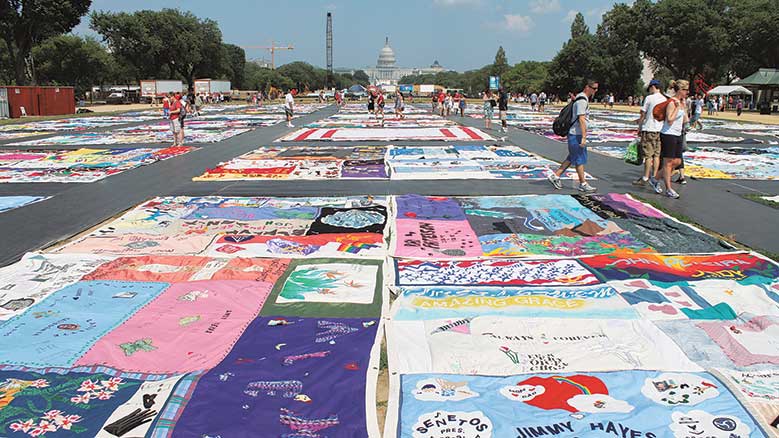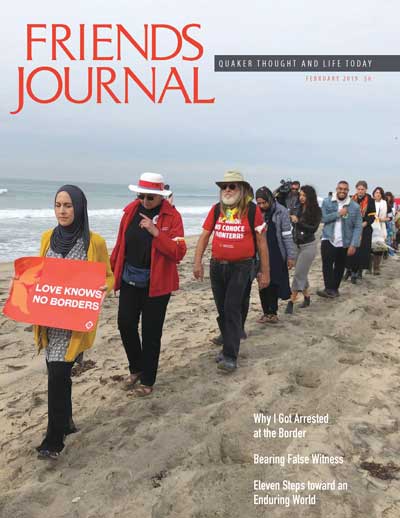
When I first started working in homeless services—during my Quaker Voluntary Service (QVS) fellowship, as a medical case manager with Boston Health Care for the Homeless Program—I thought I would do it as an openly gay man. QVS and the Quaker way inspired me to honesty. I thought that in order to bear witness with integrity, I myself had to be witnessed and had to demonstrate integrity. I thought that working with integrity meant working transparently.
The values of social services seemed to ask the opposite of Quaker values, though. During my work orientation, I recall being instructed that heart-to-heart communication and personal sharing go one way: we’re not here to have our humanity validated; we’re here to validate it in others. It seemed like an upright way of asking me to re-enter the closet as a gay person. I wondered: how can I validate the humanity of another person if I’m not in a position to validate my own? When I asked a mentoring neighbor for advice, she said that perhaps that would be my query for the year.

Lucky for me, Elle is a storyteller. And, to be honest, even with the sense of invalidation I felt around her, I really enjoyed her stories.
A woman named “Elle,” my most consistent case-management client at the day shelter where I worked, helped me explore that query most. She didn’t miss a beat. On my first day, as I walked into the shelter, Elle was laughing hysterically—to the point of snorting, spilling her coffee, and her dentures falling out of her mouth—at a picture of two men holding hands on her phone: “Hey look, they’re faggots!” she called out to me, as she continued laughing. I, meanwhile, felt humiliated. That day went on, as did the others, and through them, I oscillated between acknowledging the call to uplift people like Elle and wondering how I could do that from a place of humiliation. For a long time, I simply had to dissociate myself to work with her. I instinctively felt laughed at when she looked me in the eyes. “Hey faggot!” they seemed to say. To avoid that gaze and remain composed, I would just ask Elle about herself. Lucky for me, Elle is a storyteller. And, to be honest, even with the sense of invalidation I felt around her, I really enjoyed her stories.
For example, when I sat down with Elle to apply for food stamps, she reminisced about how, as a child, she made lunch for her younger brother every day. One day she forgot to spread the peanut butter on his two slices of white bread, and when her mother angrily asked her what she had done, she said she had made him a sandwich: a “nothing-sandwich.” Or, when I sat down to remind Elle to check her mail at the shelter, she asked me to help her write a letter to her son, and she reminisced about her days driving a taxi, and bringing him along during summer break from school, teaching him to rollerblade at Carson Beach when they stopped for lunch. Or, the way she described love life on the streets of Boston so wryly as, “My alleyway or yours, dear?,” and she laughed as she recalled one man’s heartfelt effort at a candlelit dinner behind a dumpster. “It’s okay for you to laugh, too, ” she told me. Elle gave me permission to lighten up, to find humor in the absurdity of homelessness.
Elle and I really did laugh a lot. “She’s a complete bigot,” I thought to myself, “but she has wit.” Still, it hurt to think that I was trying so hard to see Elle as a full, multifaceted human being, and she would never see me in that way, either because of my sexuality or the anonymity my job expected of me.

It dawned on me quickly: Oh—she’s making this whole thing up. It’s just a story.
This was true, until Elle shared another story, one that I became a part of. In early January 2016, on a bleak morning with scattered rain showers, Elle came to the day shelter with a broken umbrella and a bad attitude. I walked over from the kitchen with her usual request for coffee with whole milk and two sugars. She took a deep breath and was about to begin speaking when she noticed I had on a Boston AIDS Memorial Walk sweatshirt, something I had found at a thrift store a few weeks earlier. Elle looked at it for a bit, and took another breath.
“I did that walk once,” she said matter-of-factly. I was surprised. Elle is physically disabled and cannot walk without assistance from a person or a walking device. No one in that condition just “does” a memorial walk, so the next question was obvious:
“Who did you do the walk for?”
“For a neighbor of mine in the ’80s. He lived next door. He was gay. He worked as a nurse.”
Elle paused for a few moments to reflect. “He didn’t have any family in Boston, so when he got sick, really sick, I took care of him.”
“Really? For how long?” I asked, surprised, and figuring she probably brought him a casserole once.
“For two years,” she said, “right until he died.” My jaw dropped.
Elle went on to explain that she cooked this man three meals a day, cleaned his apartment, and even brought her two young kids to help.
“Why did you bring your kids with you?”
“I wanted them to learn not to be afraid of people who were sick. I also wanted to teach them how to make a bed properly; they never made their own, but they would always make his, and fold the covers back and plump the pillow—they liked it. You know, I made a quilt for him when he died, for that memorial.”
“The AIDS Quilt? You actually made a quilt patch for that?”
“Yeah,” she said, stirring her coffee very slowly and plaintively as she thought. “My kids helped me make it. I haven’t thought about that in so long.”
“Why don’t we try to find it online?”
Elle’s eyes lit up with curiosity and hope as she said, “You can do that?”
After some further recollection, Elle shared the year the man died and a defining image on the quilt patch.
“An iguana?”
“Yes. He had an iguana at one point. I can’t remember what happened to it.”
I then went to the online AIDS Memorial Quilt registry and entered the information I had into the search engine.
No results. So Elle gave me another detail: the iguana was hot pink. No results. So Elle gave me another year.
I found one quilt patch with an iguana that was lime green. “No, it was hot pink,” she called out.
I finally asked Elle for the man’s name. She took her first sip of the coffee, slowly, and said after some thought: “Julian.” I went back to the database and searched for quilts with hot pink iguanas, the first name Julian, and the year of death.
No results.
It dawned on me quickly: Oh—she’s making this whole thing up. It’s just a story.
I walked back to Elle and said, crisply, with an air of finality: “There’s no quilt patch for anyone with the name Julian.”
She quickly swallowed her coffee and said with gusto this time: “No, no, no; we called him Julian, but that was his middle name.”
She then gave me his first name, and I hustled back to the computer to change the search queries. This time three results came back, one with a hot pink iguana.
I printed the quilt patch and ran it over to Elle. She looked at the paper with eyes that seemed glazed over with a profound sense of time having passed. She said she hadn’t seen the quilt patch in over 20 years. She held it delicately, for a very long time. “For a few minutes,” she said eventually, “I forgot all about this here,” gesturing to the room, the building, everything about her present circumstances. “Thank you,” she said as she removed a plastic ziplock bag from her walker and carefully inserted the printed page. I could see that the bag held all of Elle’s medical paperwork, welfare benefits statements, and other vital information. It was literally bursting at the seams, but she made room.
Elle didn’t need to know anything about my personal life in order to sense my character that morning. I didn’t need to share anything about my life with her in order to feel connected or demonstrate it.
Over the course of the fellowship year, my job was typically not about that kind of “miscellaneous” work. It was about connecting people like Elle to income, doctors, and housing—the tangible things that enhance a person’s material condition. But this project felt like the spiritual work that needed to happen. How can you expect someone to want to live independently, advance socioeconomically, or be healthy if they don’t feel like a person anymore, or if they’ve forgotten what it’s like to be seen as worthy of those things? Elle’s quilt patch didn’t connect her with any welfare benefits, services, or housing, though perhaps it did help her remember that she is not “a homeless woman,” but a woman who has a full life; who had a life before homelessness; and who will have one after it, too.
I think the difference between those statements is extraordinary—as extraordinary as the difference between seeing someone as “a faggot” and a complex, multifaceted human being; or the difference between seeing someone as “a bigot” and a complex, multifaceted human being, one who uses homophobic language and who also cared deeply for a dying gay man. The irony was that even though I was the member of the gay community, Elle “the homophobe” had done more to uplift gay men than I ever had.
That morning with Elle helped me see that my preoccupation with myself had led me to bear false witness against her—and also against myself. Before that morning, I thought that anything short of confessing my sexuality was an undignified act of betrayal. After nearly two decades of living closeted, I thought I would have clawed at my own skin rather than submit myself to that again. I never came out to Elle that day, though, or at any point during the remainder of the year. Instead, I became willing to learn that just as there is warmth, integrity, and truth in being witnessed, there can be warmth, integrity, and even truth in anonymity. Elle didn’t need to know anything about my personal life in order to sense my character that morning. I didn’t need to share anything about my life with her in order to feel connected or demonstrate it.
That of God goes beyond words, which means real witnessing goes beyond it, too.



Dear Andrew,
Thank you for this beautiful story. I cannot describe what I felt reading it, but I don’t think I need to 🙂